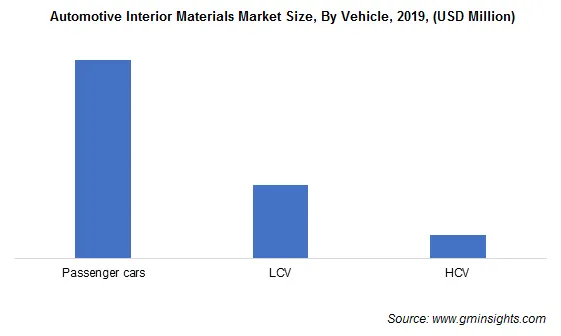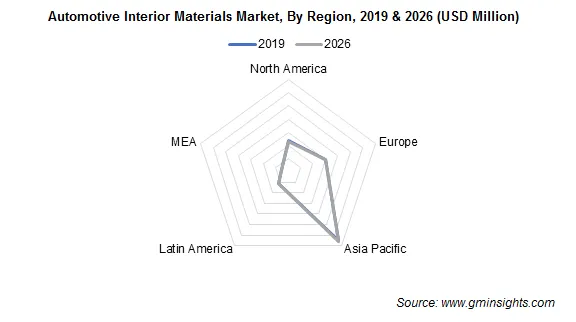Summary
Table of Content

Automotive Interior Materials Market
Get a free sample of this report
Thank you!
Your inquiry has been received. Our team will reach out to you with the required details via email. To ensure that you don't miss their response, kindly remember to check your spam folder as well!
Form submitted successfully!
Error submitting form. Please try again.

Request Sectional Data
Thank you!
Your inquiry has been received. Our team will reach out to you with the required details via email. To ensure that you don't miss their response, kindly remember to check your spam folder as well!
Form submitted successfully!
Error submitting form. Please try again.
Automotive Interior Materials Market Size
Automotive Interior Materials Market size valued at USD 27.13 billion in 2019 and is estimated to exhibit over 5% CAGR from 2020 to 2026. Growing emphasis on overall weight reduction of vehicles to optimize fuel efficiency will be a major factor augmenting the automotive interior materials demand. Lightness, superior stiffness, and strength offered by composites and modern plastics have led to their emergence as viable interior solutions.
Lighweighting is a key strategy to improve the overall fuel efficiency of a vehicle. A reduction of 10% in vehicle weight will result in around 6% - 8% improvement in the efficiency of passenger cars and 10% in battery electric vehicles.

To get key market trends
Composites and modern plastics have a strong potential in the development of energy-efficient vehicles. Major automotive manufacturers are focusing on reducing carbon emissions with the implementation of lightweight plastics and composites in vehicle instrument panels, dashboards, and flooring components.
The ongoing COVID-19 pandemic has caused a supply chain disruption across the automotive sector. International trade has been temporarily suspended by several countries across the globe, substantially impacting the automotive interior materials market demand. Furthermore, governments in most countries have imposed restrictions on citizen mobility and a temporary shutdown of production facilities in major industries as preventive measures.
Automotive Interior Materials Market Report Attributes
| Key Takeaway | Details |
|---|---|
| Market Size & Growth | |
| Base Year | 2019 |
| Market Size in 2019 | 27,126.6 Million (USD) |
| Forecast Period 2020 to 2026 CAGR | 5.3% |
| Market Size in 2026 | 27,294.0 Million (USD) |
| Key Market Trends | |
| Growth Drivers |
|
| Pitfalls & Challenges |
|
What are the growth opportunities in this market?
Automotive Interior Materials Market Analysis
Plastic material segment will generate more than USD 20 billion revenue by 2026 owing to its favorable capabilities and the vast chemical know-how of the material. Plastic is amongst the most researched materials and has gained mutual adoption in the automotive industry due to its good mechanical properties combined with excellent aesthetical appearance. With clever interior placements and improvements in manufacturing capabilities, the material witnessed a rapid growth and gained the second position amongst the most common class of materials used in vehicle manufacturing next to ferrous metals.
Seats application segment will account for over 30% automotive interior materials market share by 2026. Seats are of considerable importance as they mitigate driver discomfort during long drives or bad driving conditions. Various psychological & physiological studies on human perception, weight distribution, posture and adjustability have resulted in the use of a variety of materials.
High-performance polyurethane foams coupled with covering materials, such as leather or fabric, are used in the manufacturing of seat cushioning. The need for lightweight components in modern vehicles has also resulted in the use of carbon fibers and other performance composites in the back portion of seats.

Learn more about the key segments shaping this market
Passenger cars segment is projected to register around 5.5% growth rate during 2020-2026. These hold the major sales share with a decrease in update cycles and its consumption is set to remain high. However, several government initiatives to curb environmental pollution and material pollution have resulted in a surge in demand for composite materials. The use of thermoplastics is also on the rise due to their recyclability.
The aftermarket end user segment is expected to witness more than 6.5% CAGR through 2026 led by a large presence of small & large-scale suppliers. Components, such as floor carpets, replacement seat covers, and steering covers, will significantly contribute to the segment growth. E-commerce platforms are also anticipated to play a major role and small manufacturers will be able to expand their reach and base.

Learn more about the key segments shaping this market
Asia Pacific automotive interior materials market is likely to hold above 45% revenue share by 2026. It can be ascribed to the development in the regional automotive industry. Robust economic development, rising urbanization, increasing spending power of the middle-class populace, supportive government initiatives, etc., are some of the factors boosting the regional automotive industry growth. The proliferating demand for passenger cars coupled with rising aftermarket activities will boost the regional market demand.
Automotive Interior Materials Market Share
The automotive interior materials industry will experience intense competition in the coming years owing to the implementation of aggressive strategies, such as focused research & development activities, new product developments, acquisitions, etc., by major product manufacturers to gain a competitive advantage in the market. In October 2017, Stahl acquired BASF’s leather chemical business, thus acquiring chemical expertise for its leather chemical business and enabling significant expansion in its offerings. In May 2018, SABIC launched its PP compounds portfolio, especially for automotive interior applications, strengthening its market position.
Key automotive interior materials market participants are
- UFP Technologies
- Evonik Industries AG
- Saudi Basic Industries Corporation (SABIC)
- Arkema
- Stahl Holdings B.V.
- BASF SE
- Hexcel Corporation
- Toray Industries, Inc.
- Continental AG
- Huntsman International
- The Dow Chemical Company
- Sumitomo Chemical Company
- Trinseo S.A.
- Covestro AG
- Borealis AG
Major automotive manufacturers enter long-term supply agreements with these players to ensure the continuous supply of interior materials.
This market research report on automotive interior materials includes in-depth coverage of the industry with estimates & forecast in terms of volume in Kilo Tons and revenue in USD million from 2016 to 2026 for the following segments:
Market, by Material
- Plastics
- Thermoplastic
- Thermosetting
- Composites
- Glass Fiber Composites
- Carbon Fiber Composites
- Natural Fiber Composites
- Leathers
- Fabric
- Others
Market, by Application
- Consoles & Dashboards
- Doors
- Seats
- Steering Wheels
- Floor Carpet
- Others
Market, by Vehicle
- Passenger Cars
- LCV
- HCV
Market, by End-users
- Automotive OEMs
- Aftermarket
The above information is provided on a regional and country basis for the following:
- North America
- U.S.
- Canada
- Europe
- Germany
- UK
- France
- Spain
- Italy
- Russia
- Poland
- Asia Pacific
- China
- India
- Japan
- South Korea
- Indonesia
- Malaysia
- Latin America
- Brazil
- Mexico
- Middle East & Africa
- South Africa
- UAE
- Saudi Arabia
Frequently Asked Question(FAQ) :
Where will automotive interior materials market register traction?
Asia Pacific may account for 45% of global automotive interior materials market share by 2026, propelled by rapid urbanization and increasing economic development.
Why will global automotive interior materials market size increase through plastic material preference?
Plastic material segment may cross USD 20 billion by 2026 on account of huge chemical know-how of the material and its favorable capabilities, owing to which it has gained precedence in automotive sector.
Which application segment will propel global automotive interior materials market share?
Seats application segment may hold 30% of the industry share by 2026, driven by the increasing importance attributed to seats given that they mitigate driver discomfort.
What factors will push the demand for aftermarket segment?
Automotive interior materials market size from aftermarket end user segment may record 6.5% CAGR through 2026, driven by the huge presence of small as well as large-scale suppliers.
How will passenger cars segment fare through 2026?
Global automotive interior materials market size from passenger cars segment may record 5.5% CAGR through 2026.
What will automotive interior materials market size be valued at by the end of 2026?
In 2019, automotive interior materials industry size was worth USD 27.13 billion and it is expected to depict 5% CAGR through 2026.


